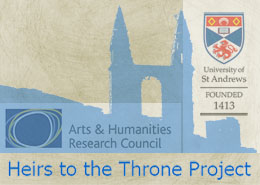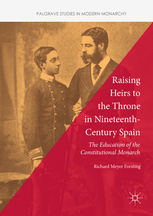Margherita: Italy’s First Heir
Maria Christina Marchi
If monarchy is played out on a stage for the whole country to see, then which act is the most important in securing the people’s hearts and interests? Matrimony, naturally. A lavish celebration to remind the people of their rulers and the essential part they play in the unity of the kingdom. At least, this was the case in Italy when Umberto, the first heir to the Italian throne, married his first cousin Margherita. The ceremony was meant to demonstrate to the recently united Italian peninsula the debt people owed to the monarchy for finally bringing the country together under one crown, one government and one label: Italians.
However, the first marriage of the House of Savoia as ruling house of Italy got off to a rather rocky start. In 1866, once the Kingdom of Italy had made peace with its Austrian neighbours, a union between the Italian heir Umberto and the Austrian Archduke Albert’s daughter Matilda was decided on. Unfortunately this bond was never formalised, as the young girl tragically died when her dress caught fire from the cigarette she was secretly smoking. Although they had never met, Umberto was very shocked by Matilda’s sudden death and plans of a new match for the prince were put on ice for almost two years.
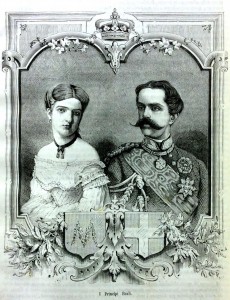
The young couple, Civiche Raccolte Storiche, Museo del Risorgimento Milano, Archivio Achille Bertarelli, Busta S 91.
Nevertheless, in January 1868 a suitable replacement for Matilda had finally been identified: Margherita of Savoia, the king’s niece and prince Umberto’s first cousin. Not only was she to become the first queen of Italy, but she would also be a wholly Italian queen. After having had a peninsula ruled by “foreign” princes for centuries, this was an ideal trait to publicise. When the engagement was announced, the Savoia-friendly newspapers exploded in a patriotic frenzy. Francesco Crispi, a leading Italian statesman, had hoped that this union would solidify his claim that “monarchy unites us, and a republic would divide us,” by providing a great show of monarchical grandeur in the name of the people. The Turin-based L’Opinione wrote that the news of the engagement had travelled like a “spark of light” down the whole peninsula, heightening national sentiments that had already been strong. Although not universal, one can see that popular interest for the Italian monarchy, which focused primarily on the “young and happy couple,” was built up during the first few months of 1868 and reached its pinnacle on 22 April: Italy’s first royal wedding day.
The descriptions of the wedding as a glorious event were probably exaggerated, and Margherita’s reported desire to involve the people, so frequently mentioned in the newspapers and her later biographies, may well have been the stuff of legend. It was rumoured, for instance, that she begged the king to allow her to wave to the crowd before the religious ceremony – breaching protocol, but demonstrating her fondness for the masses. During the wedding the focus was undoubtedly on Margherita, especially in the retelling of the event in later years, where her white gown with silver embroideries of daisies (Margherita means daisy in Italian) and diamond stars in her hair (symbol of the Italian monarchy), completely overshadowed her husband’s presence, even though he was clad in a highly decorated military uniform. Moreover, the pearl necklace left to Margherita as the future queen of Italy by the king’s late wife, Maria Adelaide – who had died in childbirth long before Italy had been unified – also sent a strong message of continuity and the tradition that the young bride was meant to represent. Thus, the wedding took on powerful symbolic meanings aimed at legitimising both the ancient dynasty and its right to rule Italy, whilst at the same time presenting the country with a new, young couple, representing a new chapter for the Italian people.
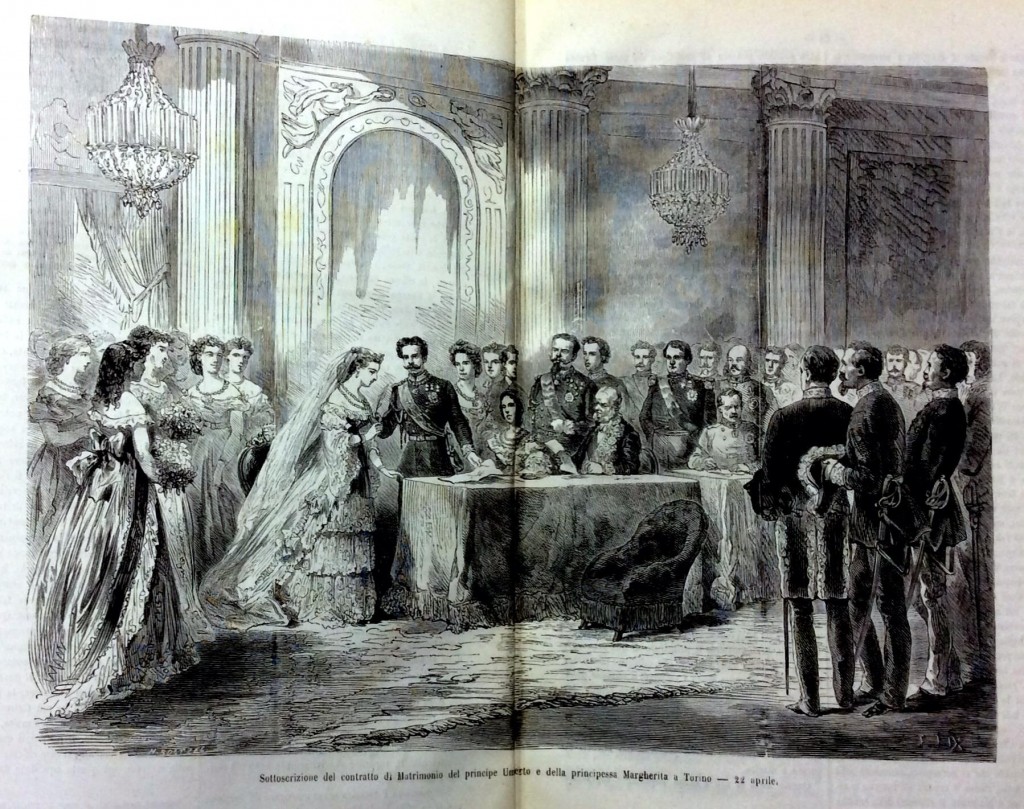
The wedding as remembered in the journal Ricordi summing up the year 1868 and its most important events, Civiche Raccolte Storiche, Museo del Risorgimento Milano, Archivio Achille Bertarelli, Busta S 91.
This new chapter of Italian life was dominated by Margherita and her talent for her new “job.” As the couple set off on their “political honeymoon” across Italy, the new heiress began to demonstrate her adeptness at manipulating her public image both as a princess of her time, wrapped up in the mystique of royalty, and as a modern royal, interacting with the people on a more “normal” level. This dual image won her popularity and turned her into one of Italy’s first celebrities, alongside the quasi-mythical Garibaldi. Her popularity was amplified by rumours of gestures she had made in honour of her people. For example, it was believed that in Bologna she had knelt down in order to kiss young schoolgirls as they came by the train station to greet the newlyweds. Consequently, even the staunchest anti-monarchist, the poet Giosuè Carducci, who had initially refused to meet the royal couple, was conquered by the princess’ manners and, by 1878, was composing odes in her honour. It is suggested in numerous biographies that, unlike her husband, Margherita understood the importance of mass support and worked hard to secure the love, or at least interest, of the people.
A year after their wedding Margherita’s pregnancy was announced and in November 1869 she gave birth to a baby boy in Naples. Once again she was lauded for her displays of charity. According to contemporary articles, the previous rulers had always asked for money when a prince or heir was born – Margherita did the opposite. She donated money to the poor, and launched an appeal for people to follow her lead in order to celebrate her son’s birth. It was also rumoured that this people’s princess attended the city’s market with her newborn in order to show it off to the local women and allow them to share in the joy of birth. All of this positive publicity, whether based on fact or rumour, brought about a new national understanding of the monarchy and its intention to become a monarchy of the people. The following year Margherita and her husband – rather than the king – were even sent to Rome to represent the monarchy, because, as Margherita’s biographer Onorato Roux stated in his La Prima Regina, the government knew that only she could succeed, “with her grace, in breaking the ice that distance the majority of the Italian high aristocracy, which remained loyal to the Vatican, to the court.”
Her role was to maintain the balance between embodying female, familial and national ideals, whilst breaking the boundaries of traditional female limitations. She was able to do so thanks to her modern understanding of the constitutional monarchy and her interest in actively nationalising the Italians through mass communication. Much more energetic than her husband during his reign as Umberto I, Margherita showed how important marriage politics continued to be for contemporary monarchies that could no longer claim to be legitimised by divine right. In short, she became the Italian monarchy’s “best asset.”
During the nineteenth century not only had female monarchical roles evolved and found in Queen Victoria an example of strong leadership, but the explosion of the mass press also created a growing cult of celebrity around certain figures. This new “politics of fame” involved people from a wide spectrum, from poets like Byron, to actresses like Sarah Bernhardt, and it also included royal figures, especially female ones, with Queen Victoria perhaps being the best-known of them all. The new attention given to royalty in this aspect meant that the importance of marriage politics went beyond the high politics sphere and became of interest to the masses. In nineteenth century Spain, the marriage between Alfonso XII, the recently restored and crowned king, and María de las Mercedes, fuelled a cult of romance that enveloped the couple who had supposedly married for love. Her death, only six months after their marriage and a few days after her eighteenth birthday, was publicly mourned, and the memory of her quickly grew into a myth. The notion that she had married Alfonso for love, and not for political arrangement, turned the couple into an epitome of true love. This notion was extremely popular with the masses, and poems and songs were written about this tragic love story, which is still present in contemporary popular culture. Although, Alfonso’s second wife was not as popular as the first, María de las Mercedes helped boost the crown’s popularity and allowed it to be enveloped by romantic notions that not only brought crown and people closer, but also allowed monarchy to be akin to more “human” emotions. Alfonso’s first wife became a celebrity of sorts, just like Queen Victoria and Margherita, who, actively or passively, showed that the female power of celebrity could be used as a political tool to aid the survival of monarchies in the 1800s.
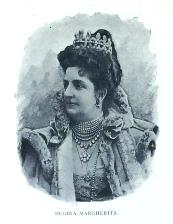
Queen Margherita in 1900, Civiche Raccolte Storiche, Museo del Risorgimento Milano, Archivio Achille Bertarelli, Busta 486.
In her transition from princess to queen, Margherita continued in her mission to help with the process of nationalisation. The myth that surrounded her person continued to grow and she and Umberto became known for their continuous travels across the country and the help they provided disaster-stricken areas with. Since the generation of Risorgimento heroes had died out, including Garibaldi and the “father of the fatherland” Vittorio Emanuele II, the new king and queen had to mould the people’s perception of monarchy, turning it into a modern monarchy that could unite its people. Whilst still remaining strong, monarchical figures, the rulers needed to adapt to a middle-class, egalitarian world, and become more approachable and “normal.” Margherita did this through her travels, her presence and her style. She became a fashion icon for all Italians, and refusing to follow Parisian trends that most of her contemporaries adored, she created her own Italian style, which was admired even by Queen Victoria. Her name was even used to name one of Italy’s trademark culinary achievements: the pizza Margherita, which was supposedly made in her honour and embodied the Italian national spirit (and flag) with its green, white and red ingredients. Whether her time as ruler helped consolidate the monarchy and nationalise the people is debatable, but it is undeniable that the construction of her persona was a successful tool of monarchical propaganda, just like that of Queen Victoria and María de las Mercedes, which allowed to showcase both the monarchy’s grandeur and its humanity.

The cover of Margherita, “a newspaper for Italian ladies,” Civiche Raccolte Storiche, Museo del Risorgimento Milano, Archivio Achille Bertarelli, Busta 546.
The power of female celebrity and “normalisation” of the monarchy, or just the importance of marrying the right person for the “job,” were key factors for the popularisation of late nineteenth century monarchies. Margherita managed to guide the House of Savoy in this direction by attempting to balance the image of herself as traditional female figure and as “modern monarch.” Advocating traditional opinions, whilst at the same time encouraging the nationalisation of the people, she took on the active role of heir to the throne and demonstrated how, through her growing popularity (everything from hospitals to fashion magazines would be named after her) how marrying the right woman was the Savoy monarchy’s best move in their attempt to secure national popularity – a key ingredient in every monarchical success story post-1800.
Suggested further reading:
Bracalini, Romano, La Regina Margherita, (Milano: Rizzoli, 1983).
Brice, Catherine, “La Monarchie, un acteur oblié de la ‘Nationalisation’ des Italiens?” Revue d’historie moderne et contemporaine 45, no.1 (Jan-March 1998), pp. 147-69.
Brice, Catherine, “Queen Margherita (1851-1926): ‘The Only Man in the House of Savoy,’” in Regina Schulte, ed., The Body of the Queen: Gender and Rule in the Courtly World, 1500-2000, (New York: Berghahn Books, 2006), pp.196-215.
Homans, Margaret, Royal Representations. Queen Victoria and British Culture (1837-1876), (Chicago: University of Chicago Press, 1998).
Körner, Axel, “Margherita. Umbertian Italy and its Monarchy,” in Politics of Culture in Liberal Italy: From Unification to Fascism, (New York: Routledge, 2009), pp. 197-220.


